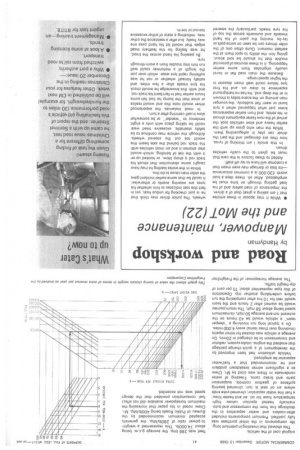Road and workshop
Page 43

If you've noticed an error in this article please click here to report it so we can fix it.
by Handyman
Manpower, maintenance and the MoT (22)
• While it may appear in these articles that I am asking a great deal of a driver, the importance of road safety and of his load getting through on time must be emphasized. After all, these days a load worth £30,000 is a common occurrence —its loss or damage may even mean that a customer will have to lay off staff.
Added to these factors is the care that must be given to the costly vehicles driven.
In this article I am thinking of tyres, how they are damaged and the part the driver can play in safeguarding them, While the man who grew up with the earlier heavy and slow vehicles took the arrival of the now faster equipment almost in his stride, and from earlier experiences knew just what happened when a tyre burst or went flat suddenly, the younger man arriving on the scene today is thrown in at the deep end. He has no background experience to draw on, and his first tyre failure could well mean disaster in the higher speed range.
Because the main road flat or burst usually originates from some earlier happening, it is these sources of potential trouble that he should be told about, giving him the ability to spot them at the earliest moment. Quite often one of the older drivers can be seen on some park or lay-by moving the palm of his hand inwards and outwards across the top of his tyre treads, particularly the steered
wheels. The junior driver may think that he is just checking for undue heat, yet in fact this test indicates to him whether his tyres are wearing evenly or otherwise; it could be that some earlier incident gave the older man cause to do this.
While in the works loading he may have caught some obstruction that struck his track rod a sharp blow, or hooked up on it with the risk of bending, which would also shorten it and on most vehicles with the track rod behind the axle beam this would toe out the steered wheels. Although the vehicle may continue to be safely steerable, excessive tread wear could be taking place with only a slight tendency to -wander", or be somewhat slow in self-centring after a turn.
In most instances the experienced driver would note this and would realize at once that the bump he had felt some hours earlier had in fact bent his track rod, and with this knowledge he would check his tyre treads after a few miles, and satisfy himself whether or not he was suffering rapid tyre wear, which over just the length of a motorway could well run him into trouble from a worn-through
tyre.
By passing his hand across the tread, he was feeling for the feathery tread edges that would let his hand pass one way freely, but offer a resistance the other way. indicating a state of either excessive toe out or toe in.












































































































